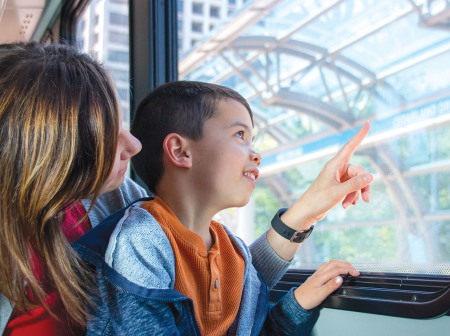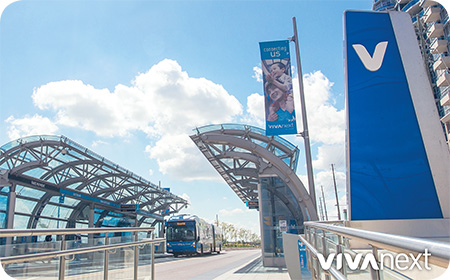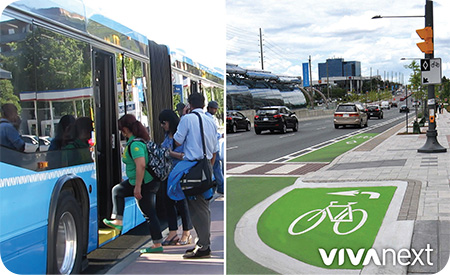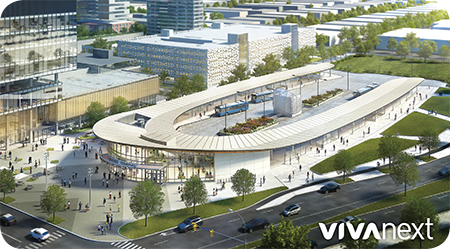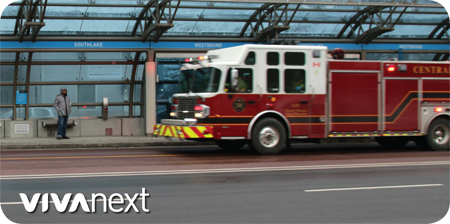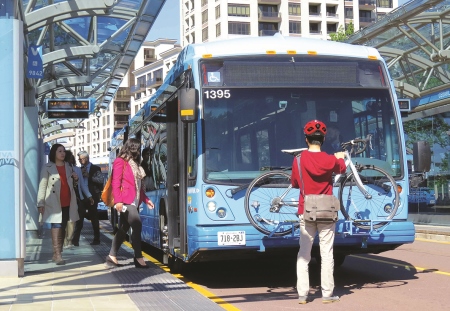
If you haven’t taken transit for a while, or are new to York Region, you may need to know a bit more about our system, and how it works.
A recent article in the Markham Economist and Sun pointed out 10 Helpful facts About York Region Transit, and it reminded us that not everyone knows the basics. We’ll cover some of the facts here, and explain a few things along the way.
history
In 2001, transit in four of York Region’s nine municipalities merged to become York Region Transit [YRT]. This was following through on a vision to have a fast, convenient, seamless transit system across York Region. York Region’s bus rapid transit – Viva – was launched in 2005, with curbside vivastations and distinctive blue buses [pictured above] custom-designed with higher capacity and enhanced comfort. More frequent service, prioritizing traffic signals, and off-board payment all meant improved service.
Viva curbside was just the beginning. In 2010, we at YRRTC began building rapidways – dedicated lanes and stations for Viva buses. As of today, we have 12.2 km of rapidways, and 18 vivastations built and open for service. By the end of this year, we should have 15 more kilometres of rapidways and 13 more stations [each station has two platforms and blue canopies – one for each direction] open for service.
Aside from YRT Local [white buses] and Viva [blue buses], YRT also operates Express routes with fewer stops during rush hours, and On-Demand service in locations and time periods with lower demand, and used by customers who need assistance or who have disabilities.
statistics
Two things stand out in YRT’s stats: many customers travelling, across a huge area. On a typical weekday, YRT serves more than 77,000 customers, and in 2016, there were 22.8 million customers. York Region is 1,762 sq. km, almost three times larger than Toronto, and 24% of the Greater Toronto Area.
To serve such a big area, YRT has a fleet of more than 500 vehicles, operates 128 bus routes and serves more than 5,300 bus stops and vivastations.
fares
While it’s possible to pay using cash either on board a YRT bus, or at a ticket machine at a vivastations, it’s convenient and a little cheaper to use a PRESTO card or the YRT Pay app [free for iOS or android]. Without these, fares are $4, or $4.50 to ride Express, or $1 to ride to GO. Using a PRESTO Card or the YRT pay app, fares are currently $3.75 for adults, $3 for youth, $2.35 for children/seniors, $4.25 to ride Express, and still $1 to ride to GO. When you board a Viva bus you can use either the front or back door and have your proof of payment ready in case YRT staff asks to see it. Fares can change over time, and when you cross borders, so if you haven’t been on YRT in a while or you’re planning to travel to & from Toronto, download YRT’s Fare Guide.
more info
Have more questions? Visit YRT.ca for schedules and maps, and excellent trip-planning tools that will tell you how to get where you’re going. They also have a feedback form and live chat options on their website, or if you need to hear a voice, call 1-866-668-3978.
future transit in York Region
Transit grows along with our vibrant city centres and busy streets. Our projects here at YRRTC include more rapidways opening in the next two years, and two YRT bus terminals – in Vaughan and Markham. Future plans that require funding include building over 75 km of rapidways along other corridors – connecting Yonge Street between Newmarket and Richmond Hill, extending Highway 7 to eastern Markham and western Vaughan, and adding Viva along Jane and Leslie Streets, and Major Mackenzie Drive. There’s more to explore of course. You can learn from YRT about their Service Plans, and learn about rapidway projects on vivanext.com. Happy travels.
